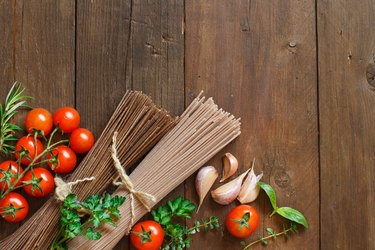
Spaghetti is the ultimate comfort food — it's rich, carb-heavy and easy to prepare. Although pasta health benefits include providing some important nutrients, such as B vitamins, satiating fiber content and low GI, the number of calories in spaghetti may not fit into your weight-loss plan.
Tip
Spaghetti is moderately high in calories and carbohydrates, so it's best to limit your portion size if you are trying to lose weight. For better results, choose whole-wheat spaghetti.
Video of the Day
Nutrition and Calories in Spaghetti
Cooked enriched spaghetti pasta contains 239 calories per cup — a significant chunk of your daily intake if you're on a weight-loss diet. For example, a cup of spaghetti will take up 12 percent of your calorie "budget" if you eat 2,000 calories per day, and 18 percent of the calorie budget in a 1,200-calorie diet.
Video of the Day
Most of the calories in spaghetti pasta comes from its 47 grams of carbohydrates, but you'll also get 9 grams of protein, plus B-complex vitamins and minerals like selenium and iron.
If you choose a whole-wheat type, the calories in spaghetti will be slightly less — 225 calories per one-cup serving — so it's easier to fit into your weight-loss plan. If you eat spaghetti twice a week, switching from white spaghetti to whole wheat will save you almost 1,460 calories per year without making any other diet changes.
Read more: The Calories in a Bowl of Pasta
Glycemic Index and Weight Loss
If you cook your spaghetti until it's very tender, you're taking in a high glycemic-index meal that might interfere with weight loss. The glycemic index, or GI, measures how significantly a food affects your blood sugar levels. The higher the GI, the faster and more sharply your blood sugar will spike after your meal.
That's less than ideal for weight loss, since rapid changes in your blood sugar levels can leave you hungry for your next meal — even if you didn't eat that long ago. People who follow low glycemic-index diets lose weight more easily than people following high-glycemic index diets, reports the Linus Pauling Institute.
Spaghetti that's been boiled for 20 minutes has a glycemic index of 58, compared to a GI of 46 for white spaghetti cooked for a more moderate amount of time. The pasta health benefits of whole-wheat spaghetti is an even better option if you're trying to lower the GI of your diet. It has a glycemic index of 42.
Benefit From Fiber
Making fiber-rich foods a regular part of your diet is key for weight loss. Colorado State University Extension notes that fiber tends to make you feel more satisfied after your meal, because it absorbs water and swells to literally fill your stomach. Fiber-rich foods are also harder to chew, which means you're less likely to eat mindlessly. A cup of white spaghetti has 2.7 grams of fiber, which is 11 percent of the daily value.
Whole-wheat spaghetti is a better option for boosting pasta health benefits from fiber. It has 6 grams of fiber per cup and provides 24 percent of the daily value.
Read more: Is Pasta Healthy to Eat?
Weight-Loss-Friendly Serving Tips
There's more to spaghetti than just the pasta, and you'll need to pick a weight loss-friendly sauce if you want to drop pounds. A half-cup serving of creamy cheese sauce, for example, can add 240 calories — and 10 grams of unhealthy saturated fat — to your meal. Tomato sauce, on the other hand, has roughly 30 calories per half-cup serving, which makes it a more diet-friendly topping.
Extend your portion size without adding many calories by serving your spaghetti with lots of vegetables. Mix cooked whole-wheat spaghetti with spiralized zucchini — which has a spaghetti-like texture — to eat a bigger portion size, or mix sauteed vegetables into your pasta sauce.
Keep it classic by topping your spaghetti with chopped green peppers, onions and mushrooms, or get more experimental by adding chopped kale, black olives and artichoke to your sauce.
- MyFoodData: "Nutrition Comparison of Pasta Cooked Enriched Without Added Salt and Whole Wheat Pasta"
- Oregon State University: Linus Pauling Institute: "Glycemic Index and Glycemic Load"
- Harvard Health Publishing: "Glycemic Index and Glycemic Load for 100+ Foods"
- Colorado State University Extension: "Dietary Fiber"
- USDA ChooseMyPlate: "All About the Grains Group"
- MyFoodData: "Nutrition Comparison of Cheese Sauce Prepared From Recipe and Tomato Products Canned Sauce"